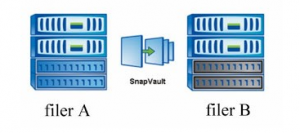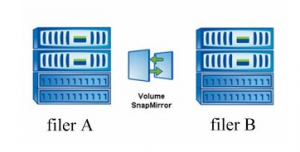What is SnapMirror?
SnapMirror is a feature that enables us to replicate data. You can replicate data from specified source volume or qtree to another destination. The destination can be on the same filer, or it can be in complete other location as long as there is a connection between source and destination.
There are three modes availabe:
- SnapMirror Sync – replicated data to the destination ASAP – so basically when data is written to the source volume it is being replicated instantly.
- SnapMirror Semi-Sync – The lag between source and destination is maximum 10 seconds. This mode give us better performance compared to sync mode, and still RPO (Recovery Point Objective) is close to be zero.
- SnapMirror Async – I would say this is the one you will probably meet the most. The snapmirror is being updated based on the schedule, it can be updated as often as every minute, or once a month. This mode I will focus on in this post.
How does SnapMirror work?
SnapMirrors task is to replicate the data from a source volume (or qtree!) to a partner destination volume (or qtree). Before using SnapMirror you have to establish a relationship between the source and the destination.
In case of SnapMirror Async you have to set up the schedule that goes to /etc/snapmirror.conf file on the destination filer/vfiler. Well – by definition you do not have to setup the schedule, but without the schedule the relationship will never get updated as long as storage admin will not update it manually.
So – how SnapMirror works when the relationship is initialized:
- Creates a Snapshot copy of the data on the surce volume
- Copies it to the destination, which can be a read-only volume or qtree
- Source and destination share the common snapshot.
As you can notice, when the relationship is initlized for the first time, step 2 is transferring all the data, in other words it is base-line copy.
How SnapMirror works when the relationship is already initialized and the update is executed:
- Create a Snapshot copy of the data on the source volume
- Compare the new Snapshot with the last common snapshot copy between the source and the destination
- Transfer to destination only the data that has changed since the last update
Let’s set up of the Volume SnapMirror a-sync relationship
Step 1. Add a proper licence to both source and destination filer:
filerA> license add xxxyyy
filerB> license add xxxyyy
Step 2. Turn on the SnapMirror
filerA> options snapmirror.enable on
filerB> options snapmirror.enable on
Step 3. Allow the access on the source (snapmirror.allow vs snapmirror.access)
filerA> options snapmirror.access host=filerB
Step 4. Create a source and a destination volume
filerA> vol create sourcevol aggr1 50g
filerB> vol create destvol aggr1 50g
Step 5. Restrict the destination volume (the destinatnio volume has to be restricted)
filerB> vol restrict destvol
Step 6. Initialize the snapmirror
filerB> snapmirror initialize -S filerA:sourcevol filerB:destvol
Transfer started.
Monitor progress with ‘snapmirror status’ or the snapmirror log.
Step 7. Check the status. If it’s empty volume the initialization shoud go really fast so after a minute or two you can see
filerB> snapmirror status
Snapmirror is on.
Source Destination State Lag Status
filerA:sourcevol filerB:destvol Snapmirrored 00:00:45 Idle
Step 8. Setup the snapmirror schedule
The snapmirror schedule has to be setup on the destination volume (/etc/snapmirror.conf)
The syntax of the schedule is:
src_system :/vol/src_vol[/src_qtree] dest_system :/vol/dest_vol[/dest_qtree] arguments schedule
Simple example, which will update the snapmirror relationship at 10 a.m. every Monday, Wednesday and Friday would be:
filerB>rdfile /etc/snapmirror.conf
filerA:sourcevol filerB:destvol – 0 10 * 1,3,5
Summary
SnapMirror is a complex technology. In this post I presented only the most simple setup of asynchronus Volume Snapmirror. If you would like to go a little bit deeper into how the transfer works, how to setup the QSM or what arguments can you specify try this book:
Data Protection Online Backup and Recovery Guide

